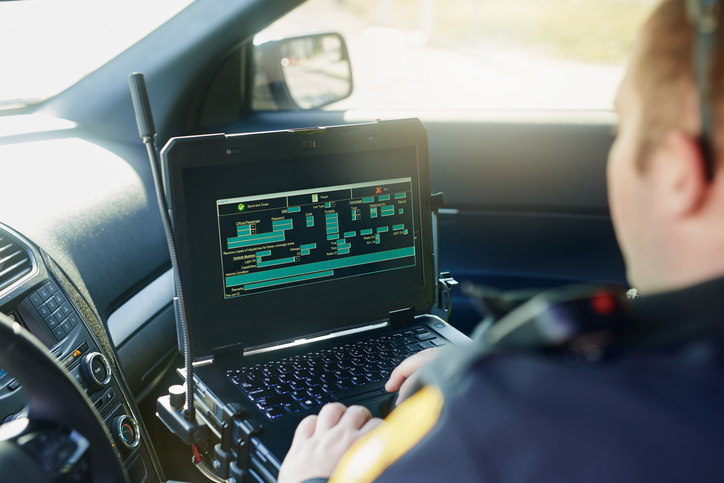Police officers watch for distracted driving and other unsafe traffic behaviors in order to keep people on the road safe, but how can we be sure that cops themselves aren’t driving distracted? The squad car has become a mobile office for police officers, fully equipped with technology like police radios, dash and body cameras, and laptops in addition to the numerous distractions that already exist in cars. On top of this, officers must search for illegal violations around them all while driving.
Captain Aaron Rankin works for the Cabarrus County Sheriff’s Office in North Carolina and is also a driving instructor for both new drivers and rookies joining the police force, a motorcycle driving instructor for both civilians and officers, and a race car driving instructor. He believes that distracted driving poses a serious threat to members of his profession.
“Through the years, it’s only become more distracting, and it’s just because of the technology we have now. It’s a requirement of the profession to drive while distracted,” said Rankin.
These distractions are a supplement to the various tasks officers are expected to practice behind the wheel. When on duty in their patrol cars, officers are expected to pay attention to their radio, traffic, people on the road, and anything that seems out of place. Needless to say, police officer distracted driving is far more common than many believe.

Law Enforcement’s Role in Distracted Driving
All drivers, but especially police officers, can fall victim to visual distractions stemming from looking at personal devices or a vehicle’s non-essential features, manual distractions resulting in taking one’s hands off the wheel, or cognitive distractions from being in a high-stress scenario or dealing with any personal issues. Excluding COVID-19 related deaths, motor vehicle crashes are the leading cause of police officer deaths, and police officer distracted driving plays no small role.
“It’s disturbing and interesting at the same time because it’s something that we can fix. It’s something that we can control, and that makes a big difference,” said Rankin.
Although every precinct is different, Rankin’s department is taking several precautions to prevent police officer distracted driving. New recruits begin their training with at least 48 hours of driving instruction on how to operate a vehicle safely while maintaining all of the other operations of a squad car. As their training continues, recruits balance driving with more and more behind-the-wheel responsibilities.
Police officers also discuss distracted driving at their mandatory in-service training conducted every year. Precincts try to emphasize the importance of safe driving and how to manage distractions while driving. For example, Rankin recommends officers try to manage distractions by slowing down or pulling over if possible.
“We know driving while distracted is part of your job, but it’s not an excuse. There are times where we know you have to take your eyes off the road, but you can decide when,” said Rankin.
Preventing Police Officer Distracted Driving
One of the most dangerous scenarios for officers and civilians alike is a high-stress vehicle pursuit. Although most precincts do not still practice pursuits, Rankin’s does and takes several additional precautions to ensure drivers’ safety. While there are sometimes two officers in one car, this is not always the case. In a pursuit, officers are taught to call for backup so that one driver can focus on keeping the vehicle in question in their sight and the other can focus on taking in radio signals and other important information.
“When the backup gets there, that officer now takes over the radio, allowing the original officer to concentrate on keeping up or keeping the violator in sight. There are many reasons behind that, but the number one is to take away a distraction in a high liability area,” said Rankin.
Rankin also says that the precinct asks officers detailed questions about their environment when in pursuits, such as their speed and the weather conditions that day. This can prevent tunnel vision, or being hyper-focused on a pursuit and losing awareness of one’s surroundings. When officers are not paying attention to all of their surroundings, they are more likely to be in a car crash.
Squad Cars and Police Officer Distracted Driving
According to Rankin, squad car manufacturers are adding features to prevent police officer distracted driving. Features like automatic braking and built-in consoles that are common in newer civilian vehicles can now be found in squad cars. Some vehicles also have newer technology specifically designed to ensure that officers are driving safely. For example, some vehicles will read the information that comes in on the computer out loud so that officers don’t need to look down while driving, and some manufacturers are adding automatic braking features that will stop a squad car if the vehicle senses that its driver is looking down.
Still, replacing existing technology and vehicles takes time and money, and it will take a while to implement these safety features at all police stations. In the meantime, precincts can continue to hold drivers’ safety training and hold their officers accountable for distracted driving-related accidents.
“It’s a choice for all of us when we get behind the wheel as to what distractions we’re going to allow to affect us. Even though it’s a requirement of our jobs as law enforcement officers to notice distractions, we still have a choice as to what distractions we’re going to take in and when,” said Rankin.




